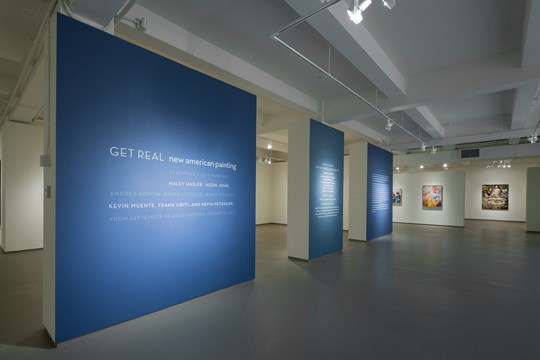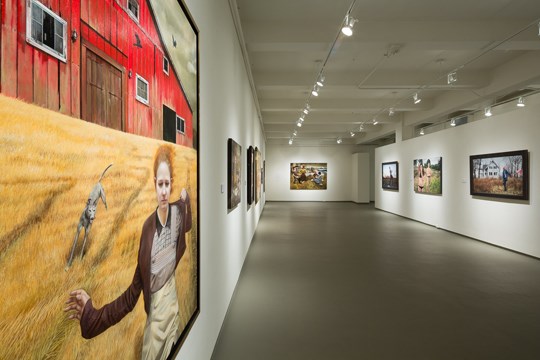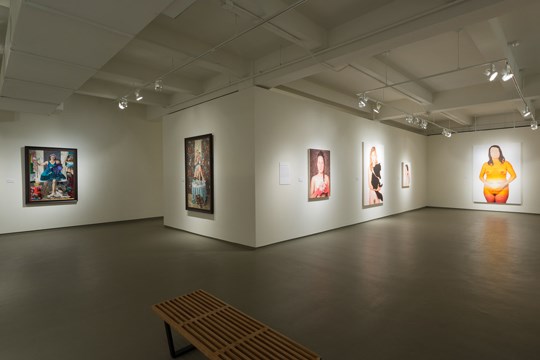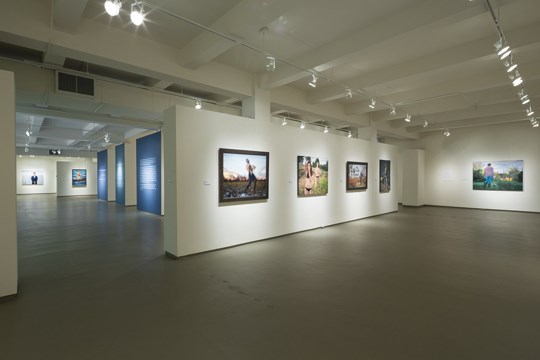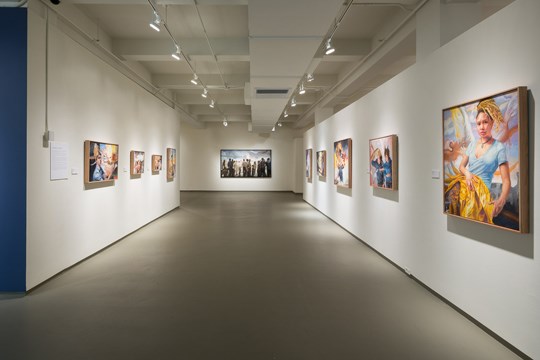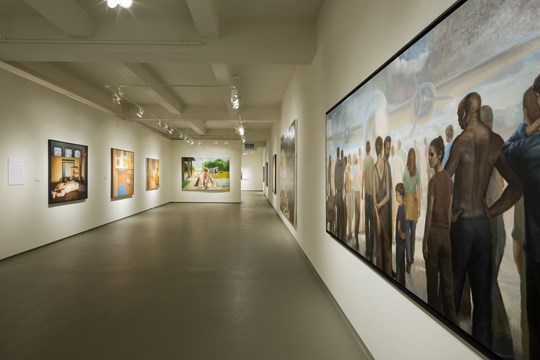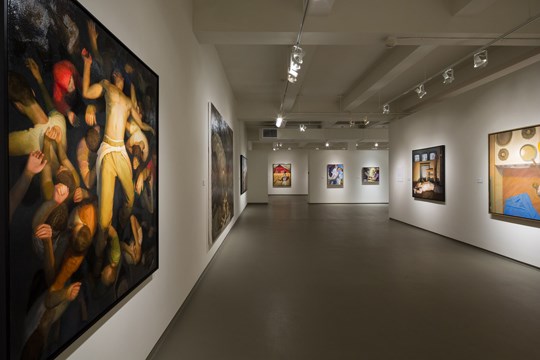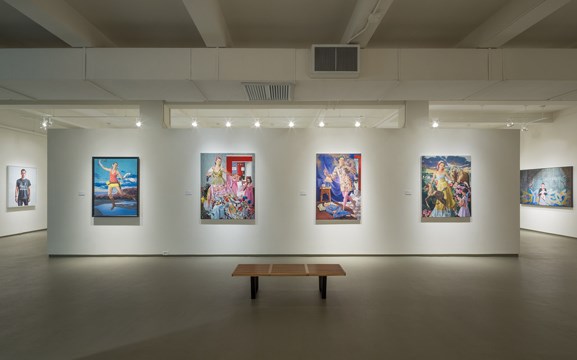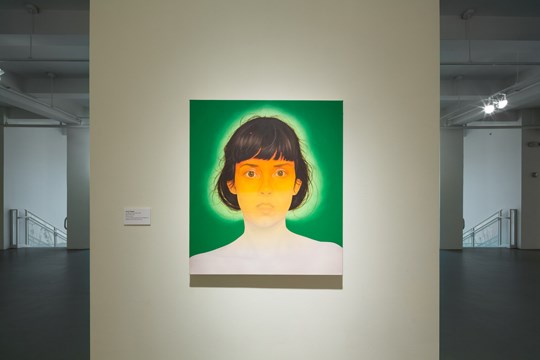GET REAL: NEW AMERICAN PAINTING
SEPTEMBER 13, 2014 - JANUARY 4, 2015
A SELECTION OF ARTISTS from across the country provides a snapshot of contemporary realist painting in the United States. Get Real's heavily figurative focus explores themes that have persisted throughout the recent history of American realist painting such as narrative portraiture and social, psychological, and magical realism.
The eight artists present a multifaceted view of the American experience, contrasting the historic and the contemporary, pastoral and urban landscapes, the personal and the universal, the immanent and the transcendent. Through the eyes of these painters, the viewer may travel between the magical depictions of a distant American heartland in work of Kowch or Muente to the hardscrabble, urban worlds of Oriti or Peterson. Whether their inspiration is drawn from memory or reality, the artists strike a balance between the everyday and the epic as seen in LeBoeuf's tightly controlled theatrical compositions or John's surreal scenes that seem to be in a state of perpetual motion. Aspects of identity and relationships, as well as issues of sexuality and femininity, are best explored through the works of Hasler and Morgan.
Although rooted in a strong tradition of art history, they are also very much products of the modern world and the global information age. These young painters from diverse educational and geographic backgrounds are charting a new path for American realist painting.
ARTISTS
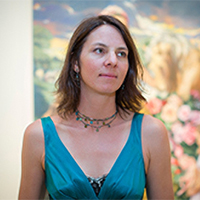
HALEY HASLER
Part biography and part theater, Haley Hasler's paintings depict ordinary life in extraordinary, exaggerated circumstances. She uses the self-portrait as a way to access the personal within the archetypal heroine. Through these iconic forms, she investigates artifice versus reality, interior versus exterior, and creator versus creation. The faces of her portraits convey the bewilderment and fatigue of young motherhood in turbulent surroundings elaborately and fastidiously executed.
Image courtesy of Thomas Hager.
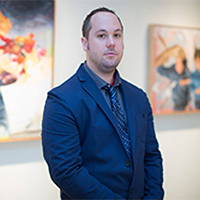
JASON JOHN
Figures with inscrutable expressions balance precarious cardboard headpieces and hold awkward poses as fruit, flowers, and abstract objects swirl around them. The paintings reveal Jason John's masterful realist technique broken by abstract fissures of dripping paint. John, an assistant professor of painting at the University of North Florida, describes his work as portraits of people in transition, with no relationship to allegory or narrative. Where his subjects have been or where they are going, he doesn't know.
Image courtesy of Thomas Hager.
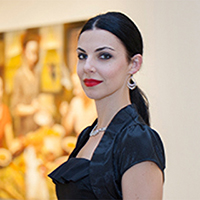
ANDREA KOWCH
Andrea Kowch's work could be described as the creative legacy of Andrew Wyeth and Alfred Hitchcock. Her haunting rural settings mask mysterious backstories. But Kowch has invented her own brand of powerful, moody symbolism with enigmatic, unfathomable characters, a rich autumnal color palette, and tense, mysterious scenes. Inspired by the sweeping Midwestern American landscapes and architecture of her home state of Michigan, Kowch's work reflects Northern Renaissance and American art influences. The carefully composed paintings achieve a three-dimensional quality that draws viewers into the action.
Image courtesy of Thomas Hager.
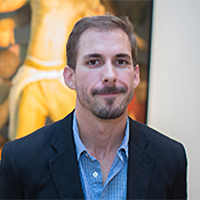
BRYAN LEBOEUF
Although shaped by memory, Bryan LeBoeuf's work springs from his imagination. He then borrows from the visual world to give it authenticity. Traditional compositions incorporate meticulously painted surfaces and lighting effects informed by European masters. His tightly controlled technique, representational subject matter, and subtly manipulated compositions create a through-the-looking-glass illusion, removing barriers between viewers and the images. He models, positions, and crops his figures to construct the impression of unseen space; viewers must imagine why a figure gazes beyond the edges of the canvas.
Image courtesy of Thomas Hager.
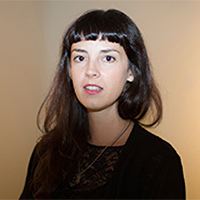
JENNY MORGAN
Although classically trained as a figure painter, Jenny Morgan is breaking with the labor-intensive preciousness associated with the realist approach. Technically intricate with a haunting quality, Morgan's paintings experiment with psychological visual realism, obscuring the physical to expose the spiritual. She obfuscates the portraits' meticulous details by annihilating their likeness, stripping away layers like physical and spiritual wounds, while retaining a striking intimacy. Like an archeologist, she digs to discover the subject's identity.
Image courtesy of Thomas Hager.
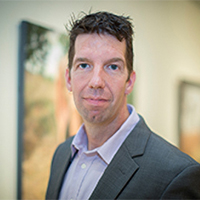
KEVIN MUENTE
In a world with a constant barrage moving images, Kevin Muente's paintings beckon viewers to slow down and contemplate a frozen, motionless moment in time. Many of Muente's surreal images deliberately cause viewers stop and ask, “What is about to happen?” Each painting's slightly ambiguous content pulls the narrative in multiple directions, keeping viewers guessing and returning for repeated examinations. Although he began painting pure landscapes, Muente later added subjects to his staged, pictorial scenes. His work explores the human experience through the metaphor of landscape by featuring archetypal figures within idealized rural surroundings.
Image courtesy of Thomas Hager.
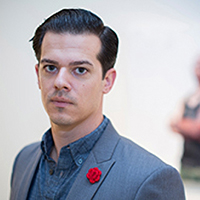
FRANK ORITI
Frank Oriti's paintings are studies in contrast. Every detail of the figures in his portraits is intricately, lovingly portrayed. But the loosely rendered, experimental backgrounds are bleak and ghostly abstract landscapes. Oriti depicts the people he's known since childhood as blue-collar protagonists, gazing stoically or perhaps with a hint of aggression. Many are former Marines and friends, some from a Cleveland steel mill where he worked between undergraduate and graduate school. Their lives, experiences, and state of mind are the backstory behind these portraits. Resignation and disappointment are etched into their faces.
Image courtesy of Thomas Hager.
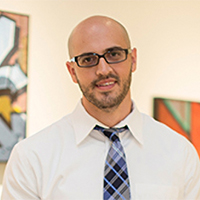
KEVIN PETERSON
Although Kevin Peterson is a figurative painter, his gritty, graffiti-covered backgrounds share the stage with his irresistible human subjects. The walls bear the scars of a ragged and dangerous world. The children are pure, young, and innocent. The two appear to be polar opposites, but the girls seem empowered by their surroundings, not afraid of them. Peterson's hyper-realistic style contrasts angelic youth against desolate, urban backgrounds, yet evidence of the painter's brush adds warmth and hope.
Image courtesy of Thomas Hager.

